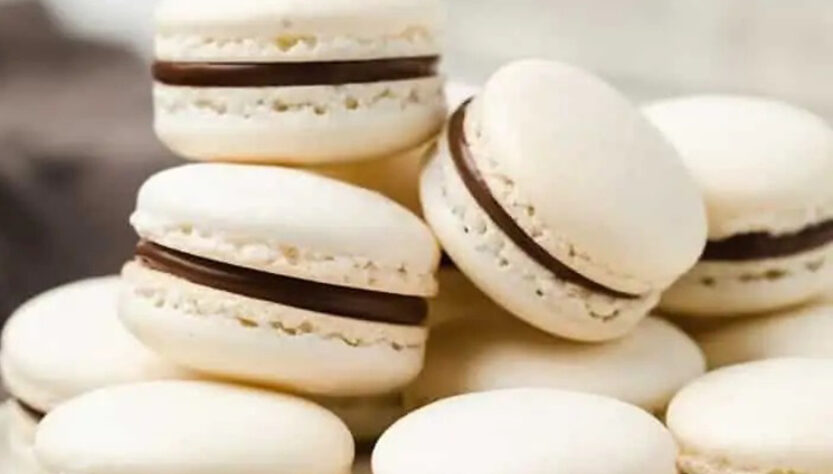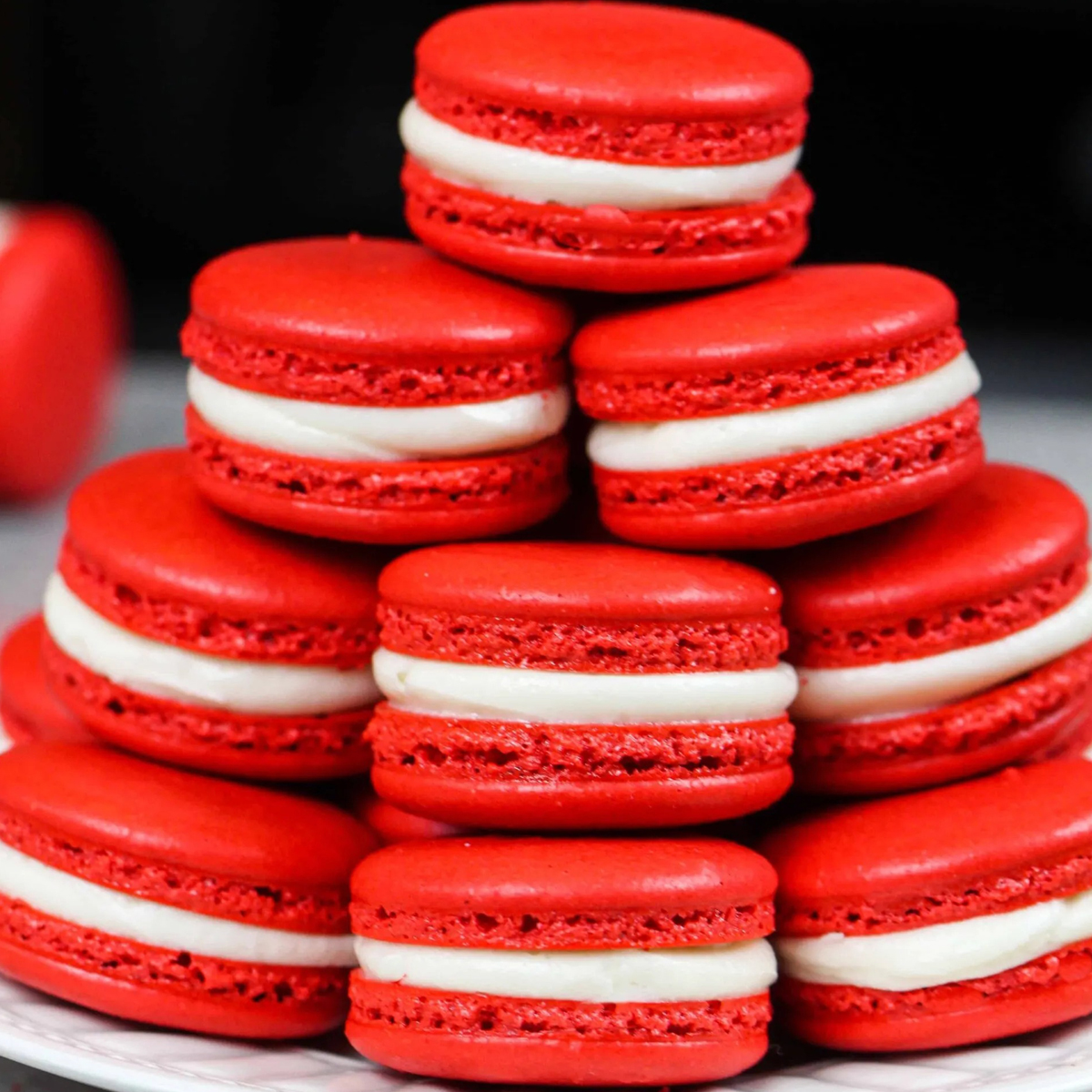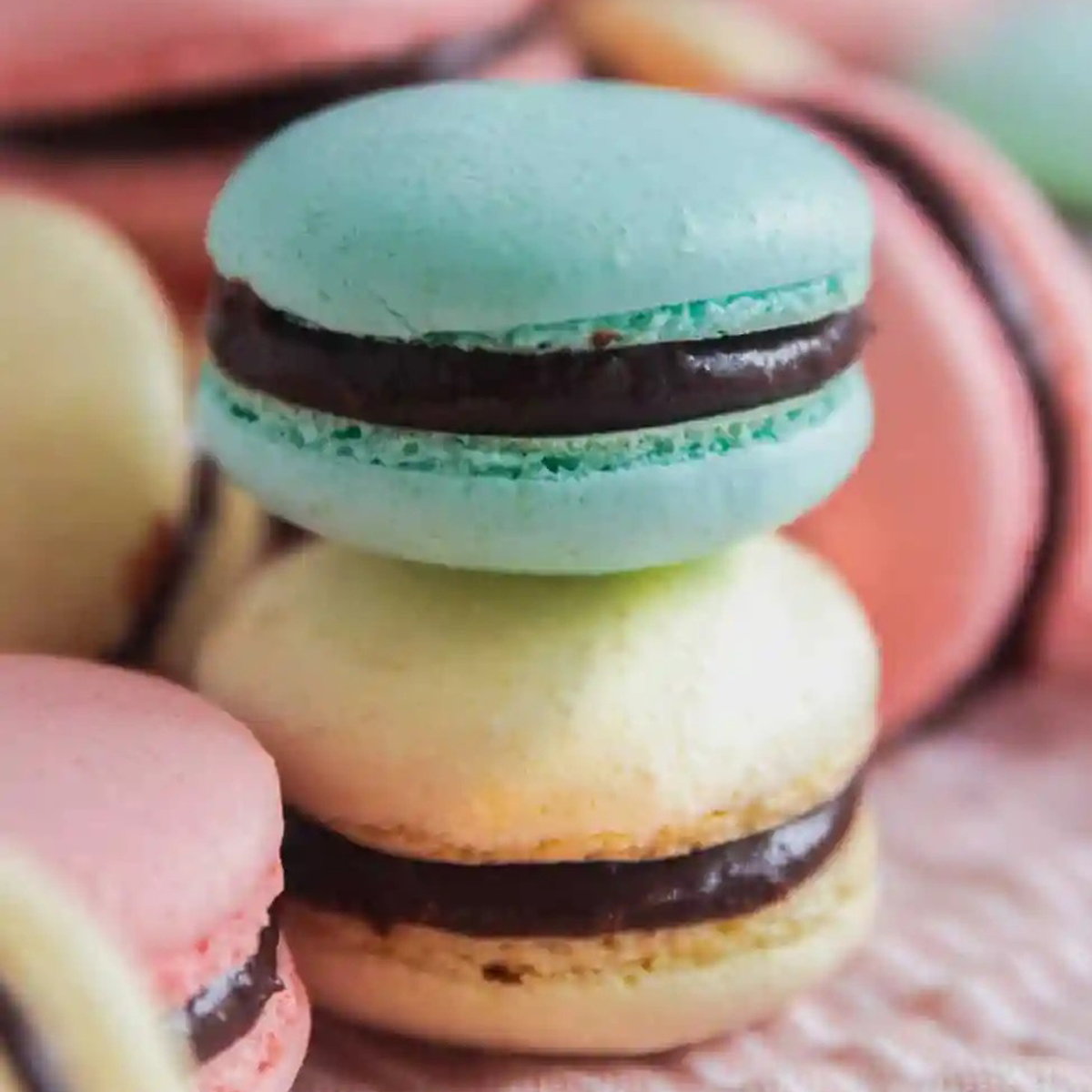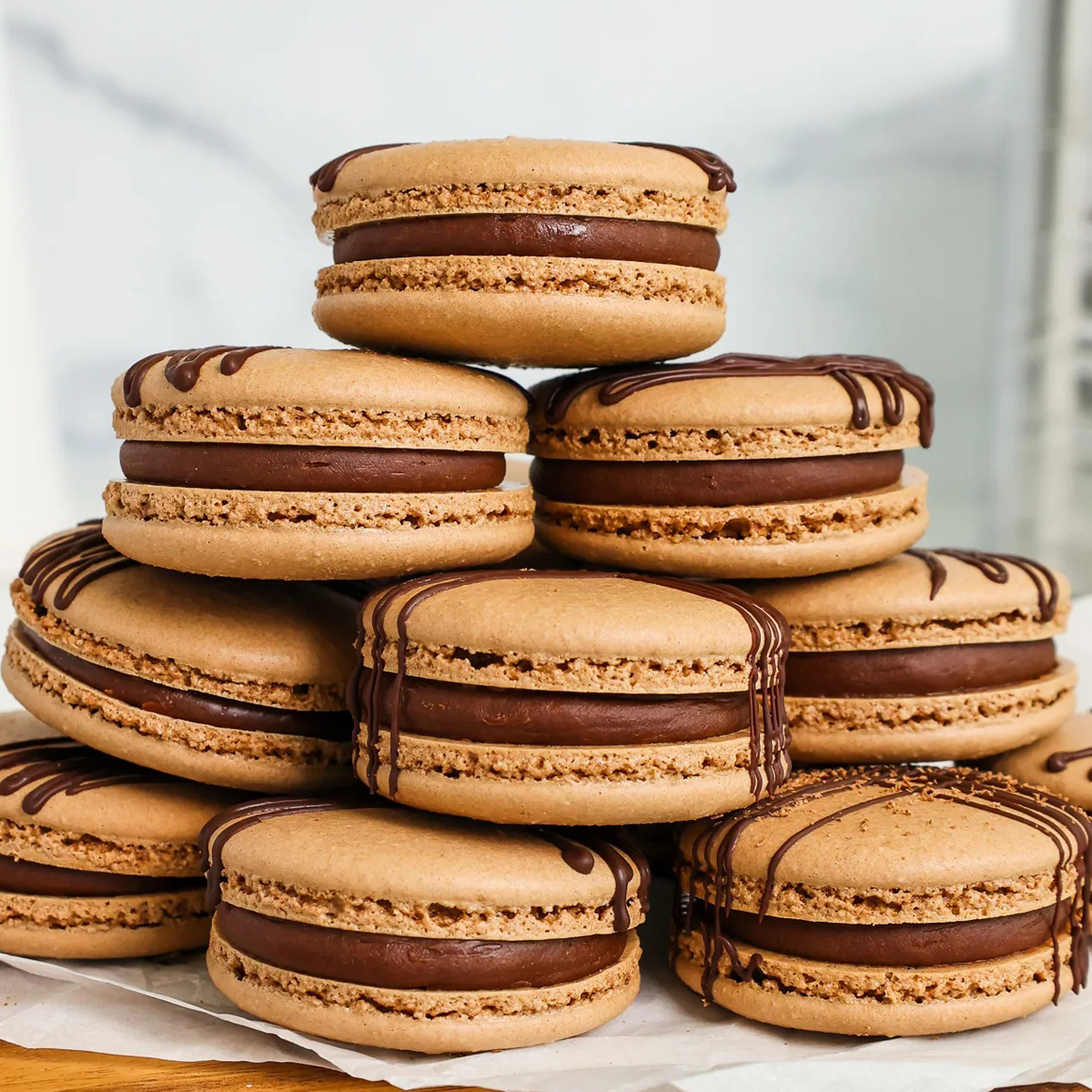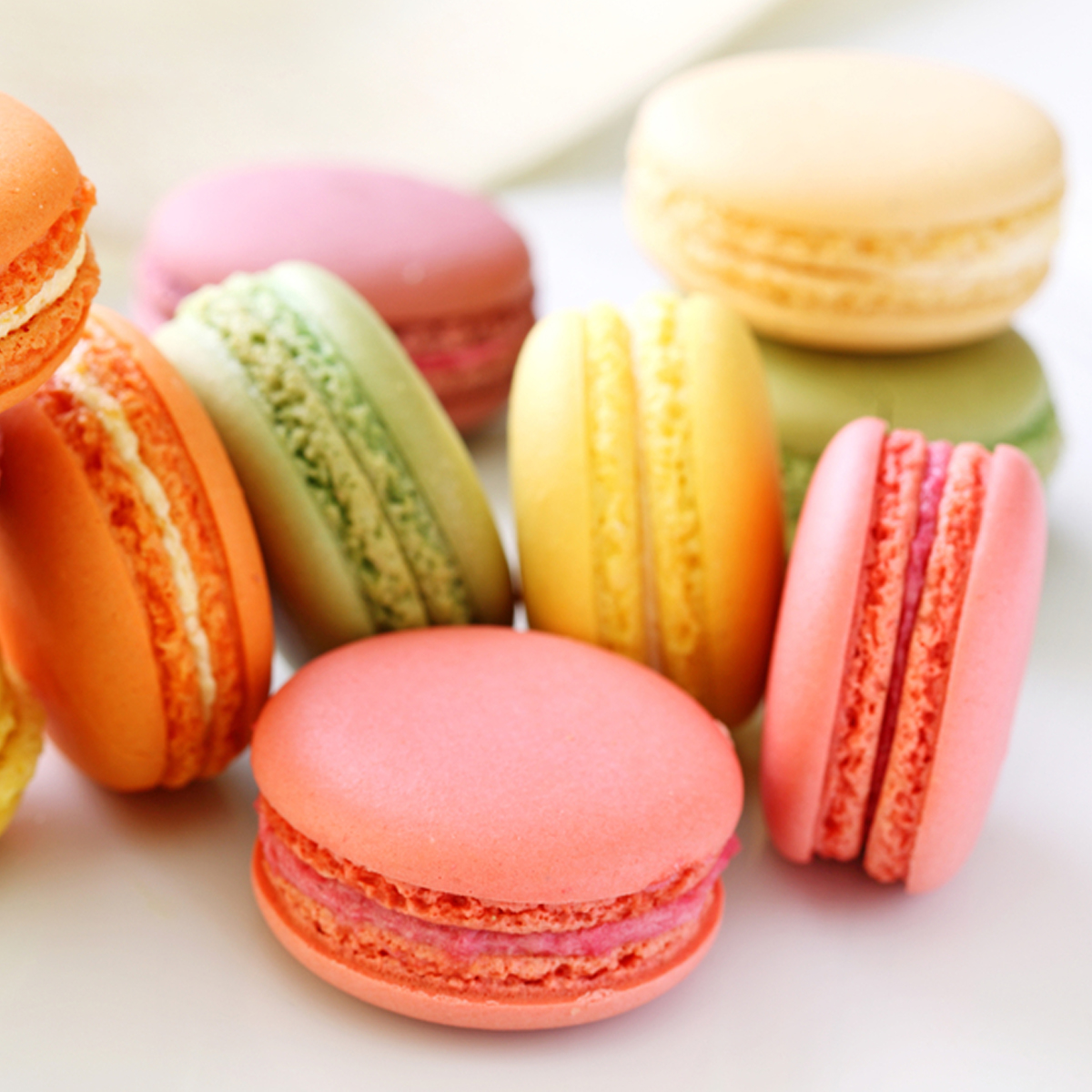Welcome to the enchanting world of Macarons! These exquisite French confections are an irresistible treat, known for their delicate beauty, crisp outer shell, and irresistibly chewy interior. Originating in the 16th century, Macarons have evolved into an artful and beloved dessert, capturing the hearts of pastry enthusiasts worldwide.
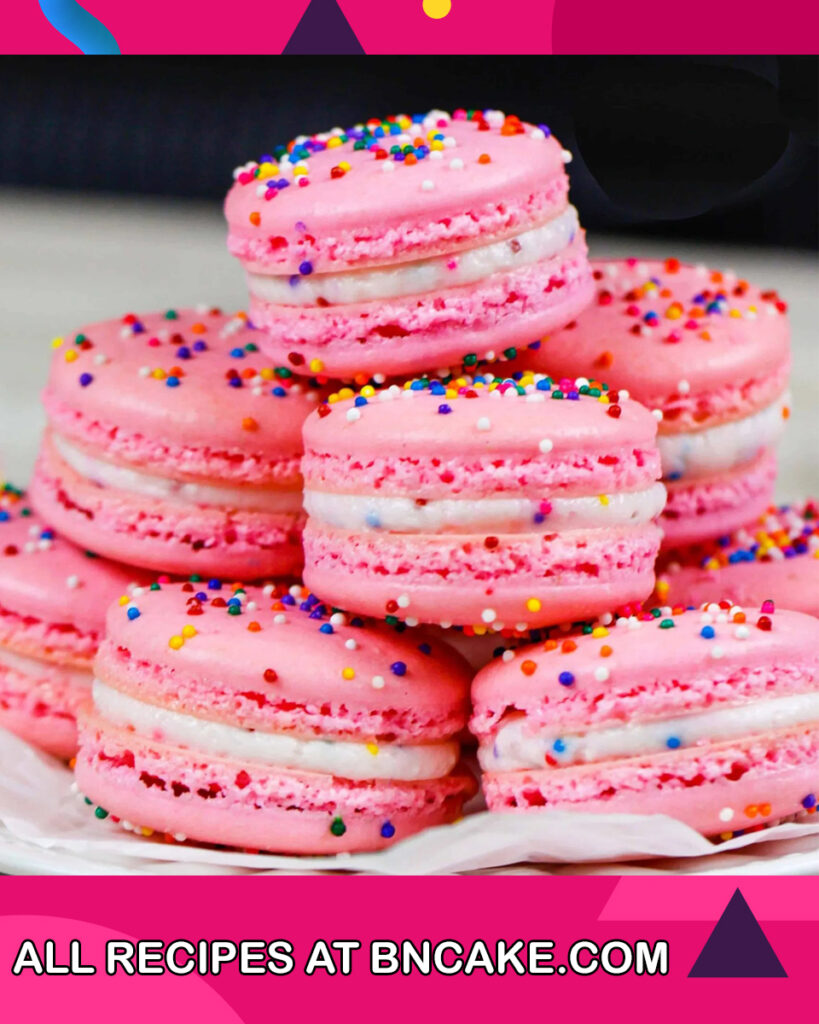
Crafted from almond flour, powdered sugar, and egg whites, Macarons are a delicate balance of flavors and textures. They come in a delightful array of colors and fillings, from classic favorites like raspberry and chocolate to more adventurous combinations like salted caramel or lavender.
Mastering the art of Macarons can be both a delightful challenge and a rewarding experience. Assembling these dainty confections requires precision and patience, but the end result is a mouthwatering masterpiece that will impress and delight all who indulge.
Whether you’re a seasoned baker or a curious beginner, Macarons are a sweet adventure waiting to be explored. Join us on this delightful journey into the world of Macarons, where elegance meets decadence, and each bite transports you to a realm of refined indulgence.
What Is Macarons?
Macarons are a delightful type of French pastry that consists of two almond-based meringue shells sandwiched together with a flavorful filling. These sweet confections are known for their iconic smooth, domed tops, and they come in a wide array of vibrant colors and flavors.
The main components of Macarons are almond flour, powdered sugar, and egg whites. The almond flour and powdered sugar are mixed together to form a fine, smooth mixture, which is then folded into stiffly beaten egg whites. This batter is carefully piped into small, uniform rounds on baking sheets, creating the characteristic circular shape of Macarons.
Before baking, the piped Macarons are left to rest at room temperature to develop a thin, smooth “skin” on the surface, which helps create the signature “feet” during baking. The “feet” are the ruffled edge that forms at the base of the Macarons, adding to their charm and texture.
After baking and cooling, the Macaron shells are filled with various fillings, such as buttercream, ganache, fruit preserves, or flavored creams. The filling provides a burst of flavor that perfectly complements the almond-based shells, creating a harmonious balance of sweetness and texture.
Macarons are a beloved dessert worldwide, renowned for their delicate and sophisticated appeal. They are often served during special occasions, afternoon tea, weddings, and various celebrations, adding an air of elegance to any dessert table.
While Macarons may seem challenging to make, they are also a delightful and rewarding baking adventure. The beauty and flavors of these dainty confections make them a cherished treat for those seeking a taste of French pastry craftsmanship and indulgence.
Why You Will Love Macarons Recipe?
You will love the Macarons recipe for numerous reasons, as it offers a delightful and rewarding experience for both bakers and dessert enthusiasts alike:
- Exquisite Elegance: Macarons are a true work of art with their smooth, domed shells, vibrant colors, and charming “feet,” making them an elegant addition to any dessert display.
- Infinite Flavor Possibilities: The Macarons recipe allows you to explore a wide range of flavors, from classic favorites like chocolate and vanilla to more adventurous options like lavender, pistachio, or rose.
- Delicate Texture: The almond-based shells offer a unique combination of a crisp exterior and a soft, chewy interior, creating a delightful and unforgettable mouthfeel.
- Customizable Fillings: You can get creative with fillings, choosing from various buttercreams, ganaches, fruit preserves, or flavored creams, tailoring each Macaron to your taste preferences.
- Impressive Presentation: Macarons are a show-stopping dessert, making them perfect for special occasions, celebrations, or when you want to impress guests with your baking skills.
- Perfect for Gifting: Macarons are not only delicious but also visually appealing, making them a thoughtful and elegant gift for friends, family, or colleagues.
- A Satisfying Challenge: While Macarons may require precision and patience to master, successfully making them can be an immensely rewarding accomplishment.
- Elevate Your Baking Skills: Attempting the Macarons recipe will allow you to expand your baking repertoire and enhance your skills in the kitchen.
- Ideal for Sharing: Macarons come in bite-sized portions, making them ideal for sharing with loved ones or offering an assortment of flavors for tasting.
- A Taste of France: Embracing the Macarons recipe gives you a chance to experience the delightful flavors and elegance of French pastry right in your own home.
In summary, the Macarons recipe promises not only an enchanting taste experience but also an opportunity to immerse yourself in the artistry of French baking. With each delicate bite, you’ll savor the sweetness and delight that Macarons bring, making them an unforgettable addition to your culinary repertoire. So, unleash your creativity, embrace the journey, and enjoy the wonders of Macarons as you embark on a delightful and delectable baking adventure.
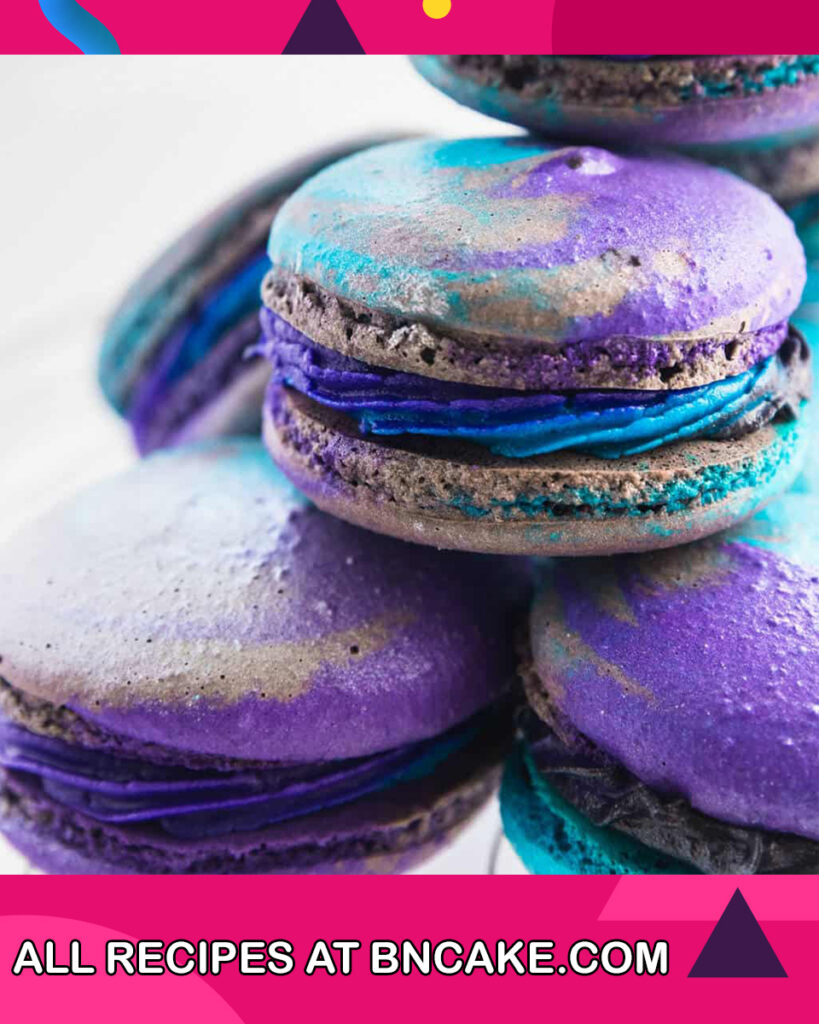
Macaron Ingredients
For the Macaron Shells:
- 110g (about 1 cup) almond flour
- 200g (about 1 3/4 cups) powdered sugar (confectioner’s sugar)
- 100g (about 1/2 cup) egg whites, at room temperature (approximately 3 large eggs)
- 1/4 teaspoon cream of tartar (optional, helps stabilize the egg whites)
- 50g (about 1/4 cup) granulated sugar
- Gel food coloring (optional, for adding color to the shells)
For the Filling:
- Your choice of filling, such as buttercream, ganache, fruit preserves, or flavored creams.
Equipment Needed:
- Food processor or almond flour sifter (to ensure a smooth texture)
- Electric mixer (stand mixer or handheld mixer)
- Large mixing bowls
- Rubber spatula
- Piping bag fitted with a round tip (about 1/2 inch in diameter)
- Baking sheets lined with parchment paper or silicone baking mats
- Fine-mesh sieve or sifter (to sift the almond flour and powdered sugar)
- Kitchen scale (recommended for precise measurements)
Yield:
This recipe yields approximately 30-36 filled macarons, depending on the size of your macarons.
Note: Macarons are a sensitive and precise dessert to make, and small variations in measurements or techniques can affect the outcome. It’s essential to follow the instructions carefully and practice to achieve the perfect balance of flavors and textures.
These classic Macarons offer an elegant and delightful treat that will impress your guests and leave them enchanted with each delicious bite. Enjoy the process of making them, and savor the joy of presenting these beautiful confections to your loved ones.
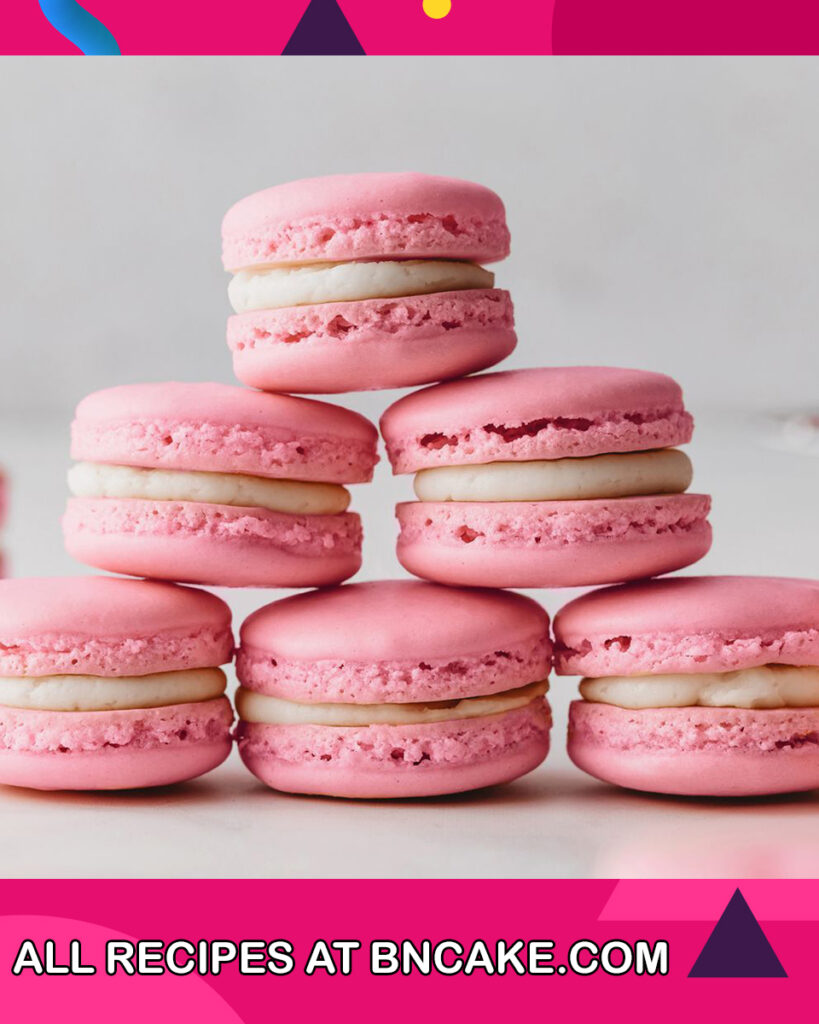
How To Make Macarons
Preparation:
- Line your baking sheets with parchment paper or silicone baking mats. If using parchment paper, you can draw circles as a guide to ensure uniform-sized macarons.
- Prepare a piping bag fitted with a round tip.
Sifting the Dry Ingredients:
- In a food processor or using an almond flour sifter, combine the almond flour and powdered sugar. Pulse or sift the mixture several times until it becomes a fine, smooth texture. Set aside.
Whipping the Egg Whites:
- In a clean and dry mixing bowl, begin whisking the egg whites on low speed until they become foamy.
- Add the cream of tartar, which helps stabilize the egg whites, and continue whisking on medium speed.
Adding the Granulated Sugar:
- Gradually add the granulated sugar to the egg whites while whisking.
- Continue whisking on medium-high speed until stiff peaks form. The egg whites should be glossy and hold their shape when you lift the whisk.
Incorporating the Dry Ingredients:
- Gently fold the sifted almond flour and powdered sugar mixture into the whipped egg whites using a rubber spatula. This process is called macaronage.
- Be careful not to overmix; the batter should be smooth and flow like lava.
Coloring the Macaron Shells (Optional):
- If desired, add a small amount of gel food coloring to the batter and fold it in gently until the desired color is achieved.
Piping the Macaron Shells:
- Transfer the batter to the prepared piping bag.
- Hold the piping bag perpendicular to the baking sheet and pipe small rounds of batter onto the parchment paper or silicone mat, using the drawn circles as a guide. Leave some space between each to allow for spreading.
Resting the Macaron Shells:
- Let the piped macarons sit at room temperature for about 30 minutes to develop a thin, smooth skin on the surface. This will help create the characteristic “feet” during baking.
Preheating the Oven:
- Preheat your oven to 150°C (300°F).
Baking the Macaron Shells:
- Bake the macarons in the preheated oven for approximately 15-18 minutes or until they are set and easily lift off the baking mat or parchment paper.
- Let the macarons cool completely on the baking sheets before carefully removing them.
Note: Macarons are delicate and sensitive to changes in temperature and humidity. Achieving perfect results may require some practice and adjustments. The success of the Macarons depends on precise measurements, proper folding techniques, and a consistent baking process.
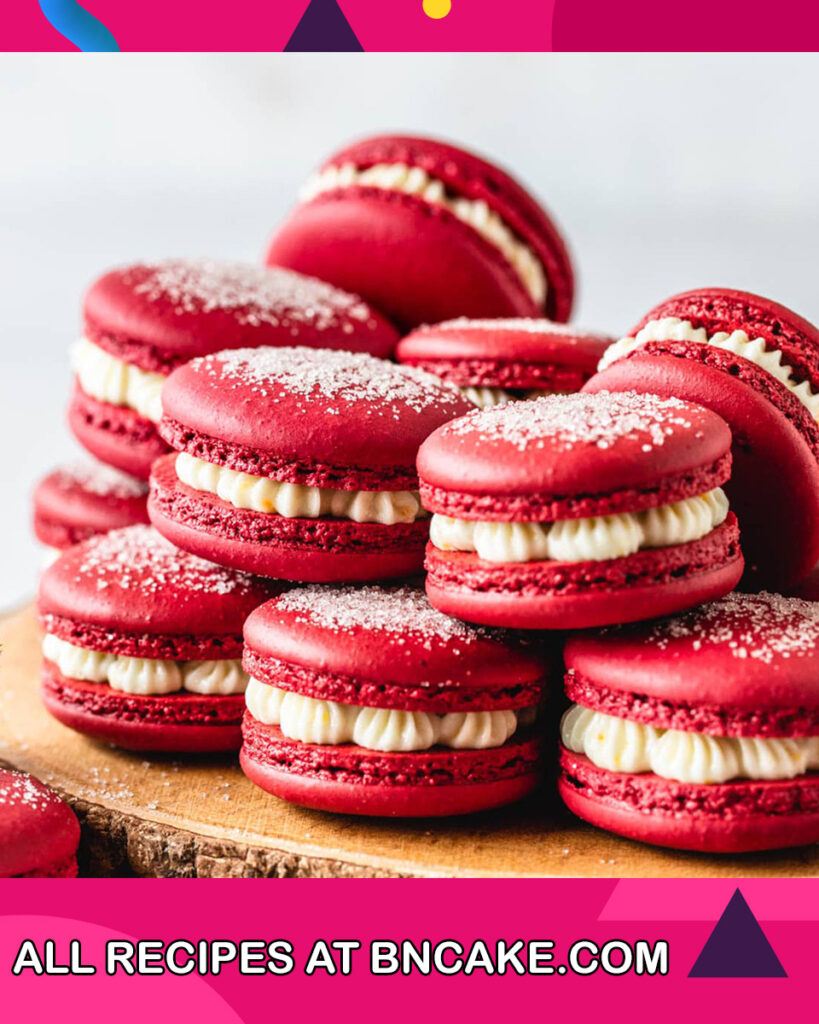
How To Serve
Serving Macarons is a delightful experience that allows you to showcase these exquisite French confections. Here are some tips on how to serve Macarons:
- Presentation: Arrange the Macarons on a decorative serving platter or dessert tray. Their vibrant colors and dainty appearance make them an eye-catching addition to any table.
- Variety of Flavors: Offer a variety of Macaron flavors to cater to different tastes. Create an assortment with classic flavors like chocolate, vanilla, and raspberry, along with more unique options like pistachio, lavender, or salted caramel.
- Pairing: Macarons pair wonderfully with a selection of teas or coffee, making them ideal for afternoon tea or a coffee gathering. Consider offering a range of hot or iced beverages to complement the flavors of the Macarons.
- Dessert Buffet: Include Macarons in a dessert buffet or dessert table spread. Their small size makes them perfect for sampling alongside other treats, allowing guests to enjoy a variety of flavors.
- After-Dinner Treat: Offer Macarons as a delightful after-dinner treat. They are a light and elegant way to end a meal on a sweet note.
- Special Occasions: Serve Macarons during special occasions, celebrations, or parties. They make for a sophisticated and impressive dessert option that will leave a lasting impression on your guests.
- Gifts or Party Favors: Package a few Macarons in a beautiful box or gift bag to give as thoughtful gifts or party favors. They are sure to delight recipients with their refined flavors and presentation.
- Temperature: Macarons are best served at room temperature. If refrigerated, allow them to come to room temperature before serving to enhance their flavors and texture.
- Labeling: If you have a variety of Macaron flavors, consider providing labels or a menu card to help guests identify the different options.
- Enjoy the Experience: Encourage your guests to take their time and savor the delicate flavors and textures of the Macarons. These treats are meant to be savored slowly, allowing each bite to be thoroughly enjoyed.
Remember that Macarons are delicate, so handle them with care when serving. Whether you’re hosting a gathering, enjoying a moment of indulgence, or giving them as gifts, serving Macarons is a wonderful way to share the elegance and refinement of these delightful French confections with your loved ones. Enjoy the enchanting experience of savoring each delectable bite!
How To Store
Proper storage is crucial to maintain the freshness, texture, and flavor of Macarons. Follow these guidelines to store Macarons effectively:
Room Temperature Storage (Short-term):
- If you plan to consume the Macarons within 1-2 days, you can store them at room temperature.
- Place the Macarons in an airtight container with a snug-fitting lid or in a bakery box.
- Keep them in a cool, dry place away from direct sunlight, heat sources, or strong odors.
Refrigeration (Medium-term):
- For longer storage, or if your Macarons have perishable fillings like buttercream or ganache, refrigeration is recommended.
- Place the Macarons in an airtight container or bakery box, with a layer of parchment paper between each layer to prevent sticking.
- Store the container in the refrigerator on one of the upper shelves to avoid temperature fluctuations.
Freezing (Long-term):
- Macarons can be frozen for extended storage, up to 2-3 months.
- Arrange the Macarons in a single layer on a baking sheet or plate and place them in the freezer for about 1-2 hours or until they are firm.
- Transfer the firm Macarons into an airtight container or a freezer-safe zip-top bag, gently removing any excess air.
- Label the container with the date to keep track of their freshness.
Thawing Frozen Macarons:
- When you’re ready to enjoy the frozen Macarons, remove them from the freezer and let them thaw in the refrigerator for a few hours or at room temperature for about 15-30 minutes before serving.
- Avoid thawing them in the microwave, as it can cause the Macarons to lose their texture and become too soft.
Note:
- Before serving, always allow refrigerated or frozen Macarons to come to room temperature to enhance their flavors and texture.
- Macarons are sensitive to moisture, so keep them away from humid environments and avoid storing them in the fridge with items that have strong odors, as they can absorb unwanted flavors.
Properly stored Macarons will retain their delicate flavors and textures, ensuring you can enjoy their delightful taste for days or even months after they are made. Whether you’re preparing them in advance for a special occasion or savoring them slowly over time, the enchantment of Macarons is sure to captivate your taste buds.

If You Love This Recipe Try These Out!
- Lemon Macarons
- Strawberry Macarons
- French Macaron
- Chocolate Macarons
- Red Velvet Macarons
- Italian Macaron
FAQs and Troubleshooting
Frequently Asked Questions about Macarons:
Why are my Macarons hollow?
Hollow Macarons can result from overmixing the batter or not tapping the baking sheet to remove air bubbles before baking. Properly folding the batter and tapping the tray can help achieve more full and evenly textured Macarons.
Why did my Macarons crack during baking?
Cracked Macarons may be caused by undermixing the batter or unevenly sized shells. Ensure the batter is mixed until it flows like lava, and use a piping template for uniform sizes.
What causes Macarons to be lopsided or uneven?
Uneven Macarons can occur if the oven temperature is not consistent, or the baking sheets are not level. Make sure to rotate the baking sheets during baking and use an oven thermometer to verify the temperature.
How can I prevent my Macarons from spreading too much?
Spreading Macarons can be a result of a batter that is too runny or overmixing. Be cautious not to over- or under-fold the batter, and ensure it has the right consistency before piping.
Why are my Macarons sticky or too soft?
Macarons can become sticky due to high humidity or not baking them long enough. Store them in a dry environment, and extend the baking time if necessary.
How can I achieve vibrant colors in my Macarons?
For vibrant colors, use gel food coloring instead of liquid coloring. Gel colors are more concentrated and won’t add extra moisture to the batter.
Why did my Macarons turn out flat?
Flat Macarons can result from overmixing the batter or underbeating the egg whites. Properly fold the batter and ensure the egg whites are whipped to stiff peaks.
Troubleshooting Macarons:
Problem: Hollow Macarons
Solution: Gently fold the batter and tap the baking sheet to remove air bubbles. Ensure the oven temperature is accurate, and avoid overbaking.
Problem: Cracked Macarons
Solution: Mix the batter to the right consistency, and use a piping template for even sizes. Check the oven temperature and rotate the baking sheets during baking.
Problem: Lopsided or Uneven Macarons
Solution: Level the baking sheets, rotate them during baking, and ensure the oven temperature is consistent.
Problem: Macarons spreading too much
Solution: Check the batter consistency, avoid overmixing, and ensure the oven temperature is accurate.
Problem: Sticky or too soft Macarons
Solution: Store the Macarons in a dry environment, and extend the baking time if needed.
Problem: Flat Macarons
Solution: Properly fold the batter, ensure stiff peaks when beating the egg whites, and avoid overmixing.
Remember that making perfect Macarons may take some practice, and small variations in measurements or techniques can affect the outcome. Don’t be discouraged by any issues-enjoy the process and adjust your approach with each attempt. With patience and practice, you’ll be able to master the art of creating beautiful and delicious Macarons that will impress and delight.

Note about Macarons
Step into a world of elegance and delight with Macarons! These exquisite French confections are a true testament to the artistry of pastry-making. With their delicate almond-based shells and a myriad of delectable fillings, Macarons offer a symphony of flavors and textures that dance on your palate.
Crafting these charming treats requires precision and patience, but the results are nothing short of enchanting. From the crisp exterior to the soft, chewy center, each bite is a moment of blissful indulgence.
As you embark on your Macaron-making journey, remember that perfection may take practice, but the joy lies in the process. Embrace the challenge, savor the sweetness, and relish the satisfaction of creating something truly special.
Whether for an elegant tea gathering, a celebration, or as thoughtful gifts, Macarons add a touch of sophistication to any occasion. Share the delight of these dainty confections with loved ones and let the magic of Macarons unfold.
Enjoy the delightful art of Macarons-one delicate morsel at a time.
Nutritional Information
The nutritional information for Macarons can vary depending on the specific recipe and the type of fillings used. However, here is a general approximation of the nutritional content for one standard-sized Macaron (approximately 10-12 grams):
Calories: 50-70 kcal, Total Fat: 2-4g, Saturated Fat: 0-1g, Cholesterol: 0-5mg, Sodium: 0-10mg, Total Carbohydrates: 6-8g, Sugars: 5-7g, Protein: 1g
Keep in mind that the nutritional content can vary significantly depending on the size of the Macaron and the filling used. Macarons are a sweet treat and should be enjoyed in moderation as part of a balanced diet. If you have specific dietary concerns or health restrictions, it’s best to consult with a registered dietitian or nutritionist for personalized nutritional advice.

